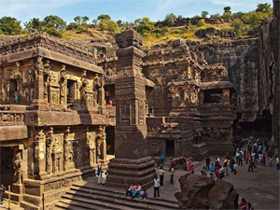Examine how different religions influenced cave architecture in India with special emphasis on Buddhist influences. (150 words)
Sakshi Education
By Srirangam Sriram, Sriram's IAS, New Delhi.


The western Deccan region saw initial excavation of caves and has the early cave structures associated with Buddhism. The development of early cave architecture in India can be traced from the early reference pointof the Lomash Rishi and Sudama caves in the Barabar hills. Rock-cut Hindu and Buddhist sculptures can be seen in these caves.

The cave architecture in India was prominently associated with varying religious themes and regional variations. The relics, motifs, murals and sculptures of the caves gives an impression of various traditions, customs and lifestyles followed by the inhabitants.
Some of the other earliest cave architecture include the Bhaja Caves, the Bedsa Caves, the Karle Caves, the Kanheri Caves and some of the Ajanta Caves.
Influence of different religions on cave architecture
Influence of different religions on cave architecture
- Buddhist influence
- Some of the finest examples of cave architecture can be found in the ancient Buddhist caves. Buddhist monks used the caves as shelters and shrines.
- The earliest caves comprising of cave temples that are associated with Buddhism include the Karle Caves, the Kanheri Caves, the Bhaja Caves, the Bedsa Caves and the Ajanta Caves.
- Association of Buddhism with trade and commerce and early involvement of the Buddhists with traders influenced them to locate their monastic establishments in close proximity to major trade routes.
- The caves gradually became more enhanced and elaborate. These included sectionalizing areas for specific purposes like the viharas (residential area for monks) and chaityas (congregational worship areas). Interior of the Chaitya included the stupa as the object of veneration.
- The areas were embellished with fine carvings, reliefs and paintings. Some caves also included elaborate facades, arches and pillars. During the later phase, there was emphasis on the greater sculptural ornamentation on the outer walls. Later caves were also decorated with murals depicting stories and figures from the Buddhist Jataka stories.
- Hindu influence
- The Hindu caves that are located at different places across India are sort of extensions of Buddhist cave architecture with certain alterations in architecture and design.
- Themes from the epics like the Ramayana and the Mahabharata are depicted in the structures.
- The most prominent features of Hindu cave architecture are the presence of mandapa and ratha (chariot) that developed during the Dravidian period.
- Jain influence
- Jain cave architecture can be noticed in the caves of Udayagiri and Khandagiri. These caves have no congregation halls or rock-cut shrines. However, in later period, some were enlarged and converted into shrines.
- Tiny cells excavated from the rock reflect the hard ascetic regimen of the monks who lived in these caves. The outer façade and brackets have carved ornamentation.
- The sculptural decoration of some caves share certain features with early Buddhist sites, such as honeysuckle design and winged animals. Trees, lotuses, snakes and animals such as the horse, lion, and elephant occur in few places on pilasters.

The cave architecture in India was prominently associated with varying religious themes and regional variations. The relics, motifs, murals and sculptures of the caves gives an impression of various traditions, customs and lifestyles followed by the inhabitants.
Published date : 26 Oct 2020 01:16PM













